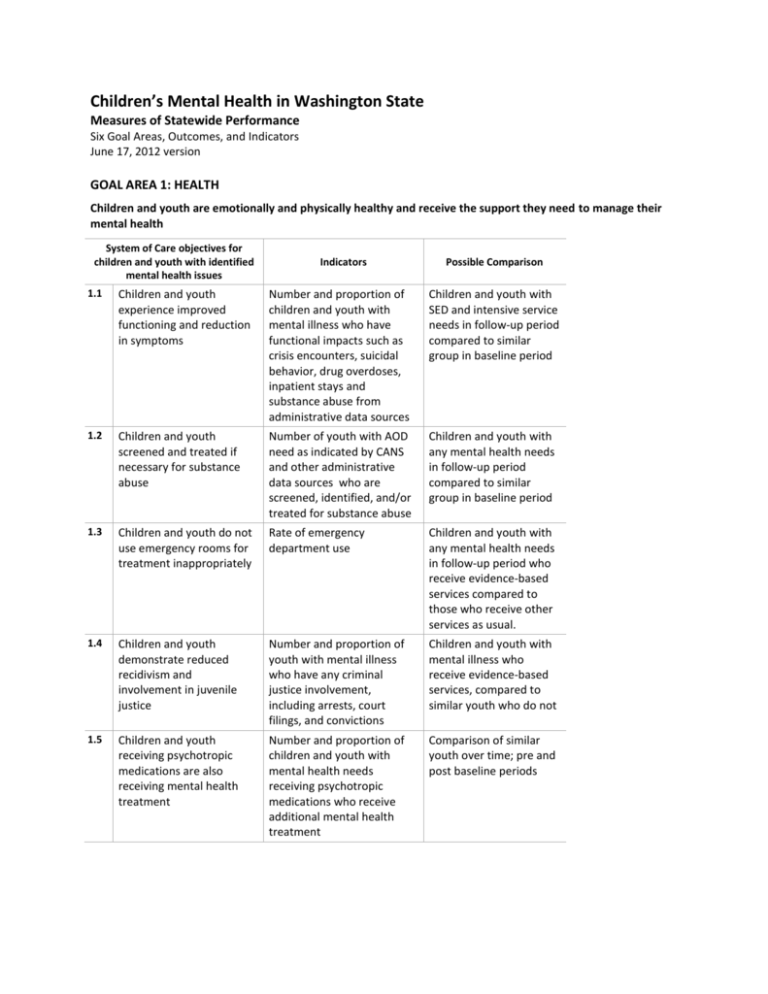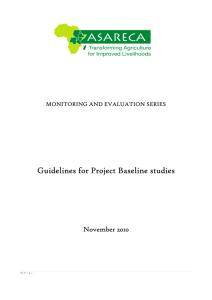Child Dashboard Measures - North Sound Mental Health
advertisement

Children’s Mental Health in Washington State Measures of Statewide Performance Six Goal Areas, Outcomes, and Indicators June 17, 2012 version GOAL AREA 1: HEALTH Children and youth are emotionally and physically healthy and receive the support they need to manage their mental health System of Care objectives for children and youth with identified mental health issues Indicators Possible Comparison 1.1 Children and youth experience improved functioning and reduction in symptoms Number and proportion of children and youth with mental illness who have functional impacts such as crisis encounters, suicidal behavior, drug overdoses, inpatient stays and substance abuse from administrative data sources Children and youth with SED and intensive service needs in follow-up period compared to similar group in baseline period 1.2 Children and youth screened and treated if necessary for substance abuse Number of youth with AOD need as indicated by CANS and other administrative data sources who are screened, identified, and/or treated for substance abuse Children and youth with any mental health needs in follow-up period compared to similar group in baseline period 1.3 Children and youth do not use emergency rooms for treatment inappropriately Rate of emergency department use Children and youth with any mental health needs in follow-up period who receive evidence-based services compared to those who receive other services as usual. 1.4 Children and youth demonstrate reduced recidivism and involvement in juvenile justice Number and proportion of youth with mental illness who have any criminal justice involvement, including arrests, court filings, and convictions Children and youth with mental illness who receive evidence-based services, compared to similar youth who do not 1.5 Children and youth receiving psychotropic medications are also receiving mental health treatment Number and proportion of children and youth with mental health needs receiving psychotropic medications who receive additional mental health treatment Comparison of similar youth over time; pre and post baseline periods GOAL AREA 2: HOME Children and youth live in safe, stable, home or home-like settings that support their resilience and well-being System of Care objectives for children and youth with identified mental health issues Indicators Possible Comparison 2.1 Children and youth live and receive treatment in the context of their family, home, and other natural settings Proportion of services delivered in community or outpatient settings; services treatment received in home or community, outpatient, and inpatient services, will be analyzed together and separately Comparison of similar youth over time; pre and post baseline periods 2.2 Children and youth have less long-term inpatient stays and shorter inpatient hospitalization stays Number and proportion of children and youth with long-term inpatient stays and length of inpatient hospitalizations Comparison of similar youth over time; pre and post baseline periods GOAL AREA 3: PURPOSE Children and youth learn, work, and contribute meaningfully to their community System of Care objectives for children and youth with identified mental health issues Indicators Possible Comparison 3.1 Children and youth are successful in school Achievement, attendance, continuous enrollment, CANS functional indicator Children and youth with mental illness who receive evidence-based services, compared to similar youth who do not 3.2 Youth complete high school High School Graduation and GED Children and youth with mental illness who receive evidence-based services, compared to similar youth who do not GOAL AREA 4: COMMUNITY Youth are engaged in relationships and social networks that provide support, friendship, love, and hope System of Care objectives for children and youth with identified mental health issues 4.1 Families and natural supports are fully integrated into treatment Indicators Possible Comparison Integration of family members and natural supports on CFTs as assessed by Child and Family Team quality tool reported satisfaction levels Youth with SED who receive intensive services and/or wraparound, compared to similar youth who receive no services or services as usual. 4.2 Youth and families have access to peer support when needed Number of certified peer counselors accessed by parents, caregivers and youth Comparison of similar youth over time; pre and post baseline periods GOAL AREA 5: PRACTICE Services are family-driven, youth-guided, integrated, developmentally appropriate, and culturally competent, and practice is evidence based Outcomes Indicators Possible Comparison 5.1 Duplication of care and care plans is minimized Child and Family Team (CFT) quality tool satisfaction survey questions Kids with intensive services compared to similar group where such services have not yet been phased in 5.2 Services are integrated, flexible, and capable of meeting individualized needs, including the needs of youths with the most complex needs Services received are consistent with findings from CANS assessment and measures constructed from admin data Kids with intensive services in follow-up period compared to similar group in baseline period (admin data only) 5.3 Services, supports, and practices are research or evidence-based Proportion of services that are EBP's Kids with MI receiving EBPs in follow-up period compared to similar group in baseline period GOAL AREA 6: SYSTEM A comprehensive continuum of effective services, from prevention, early identification, and intervention through crisis intervention and inpatient treatment, and including care coordination and peer support, is available and accessible Outcomes Indicators Possible Comparison 6.1 The system provides a comprehensive and accessible array of services for children, youth, and families The availability of child and family teams, EBPs and mental health treatment across the state relative to estimated need Comparison over time; pre and post baseline periods 6.2 The system is characterized by accessibility and equity in access to care for children, youth, and families The proportion of mental health and substance abuse treatment services delivered across the state by gender, race, ethnicity, and geography, relative to estimated need Comparisons of those receiving needed mental health and other services by race/ethnicity/RSN










